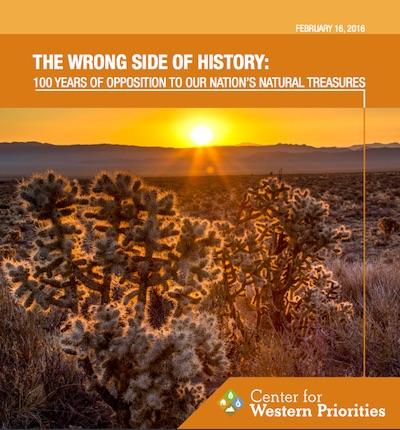
Late in the 19th century, as conservationists pushed to preserve the Grand Canyon, local opposition stalled action with arguments like “the fate of Arizona depends exclusively upon the development of her mineral resources.”
More than 100 years later, a proposal to permanently ban uranium mining on 1.7 million acres surrounding Grand Canyon National Park has prompted similar criticism, as U.S. Rep. Paul Gosar of Arizona said such a designation “will kill jobs, stifle development, permanently prevent mining and future grazing leases ... in northern Arizona.”
A new report from the Center for Western Priorities -- The Wrong Side of History: 100 Years of Opposition to Our Nation’s National Treasures -- says these pro-development arguments haven’t changed over the past century despite data showing that public lands ultimately benefit local economies. In the case of the Grand Canyon, the report cites National Park Service data from 2014 that attributes 4.8 million visitors, 7,846 jobs, and $711 million in economic contribution to the park.
The report comes on the heels of President Obama’s designation of three national monuments in California as well as amid increasingly divisive land-use proposals in Maine and Utah. U.S. Rep. Rob Bishop of Utah, the chairman of the House Natural Resources Committee, called President Obama’s use of the Antiquities Act in California “presidential bullying” and said that “the land will not be better protected and people will be harmed.”
“Chairman Bishop is carrying on a proud tradition of anti-park naysayers that dates back to the founding of our first national parks, when critics warned that protecting the Grand Canyon from mining was a ‘fiendish and diabolical scheme,’” Greg Zimmerman, policy director at the Center for Western Priorities, said in a release. “As history has proven time and again, our newest national monuments will be good for California’s economy, good for local communities, and good for future generations.”
In addition to the Grand Canyon, the report outlines similar arguments and numbers from five other national parks -- Yellowstone, Olympic, Glacier Bay, Canyonlands, and Redwood -- as well as recent proposals in New Mexico and Utah.
Dr. Alfred Runte, author of National Parks: The American Experience and one of the country’s leading environmental historians, said “we shouldn’t have to support our national parks with economic arguments. We shouldn’t have to say we employ ‘X’ number of people.”
He said the best land for resources and development outside Alaska fell into private ownership by the early 1900s due to the Homestead Act and similar laws.
“We’re fighting over leftovers. We’re fighting over lands that don’t have the best and don’t have the most. This country is not going to support itself economically from its public lands,” Dr. Runte said Saturday during a phone conversation. “The best lands are still in private hands, and anybody who tells you otherwise is full of baloney. So what are you fighting over? You’re fighting over nothing.”
To illustrate his point, Dr. Runte described how residents near Malheur National Wildlife Refuge in Oregon were “very nervous” during a recent weeks-long occupation by protesters. After the Hines Lumber Co. overlogged and laid employees off years ago, tourism from bird-watchers became the primary economic driver for the region.
“They know that the public lands don’t mean anything as ranchland,” Dr. Runte said. “When the tourists come to town to see the birds, … they stick around” at local hotels and restaurants.
In Colorado, an uptick in tourism has been noted in the first year after Browns Canyon National Monument was designated last February as a national monument by President Obama with the Antiquities Act. In recognizing the first anniversary last week, Friends of Browns Canyon issued a release stating that the Chaffee County Visitors Bureau reported a 9.5 percent increase in lodging tax revenue from 2014 to 2015.
“People come in every day asking about the Browns Canyon National Monument,” Joe Greiner, owner of Wilderness Aware Rafting, said in the release. “I anticipate that it will have even more of an impact on our business in the upcoming year.”
Back at the Grand Canyon, poll results released last week showed local support for the new monument around the national park. At the same time, a state House committee advanced a bill (HB2585) that would restrict any monument to the “smallest area compatible with the proper care and management of the objects to be protected,” as outlined in the Antiquities Act, the Arizona Republic reported.
“There's no public input,” Rep. Bob Thorpe, a sponsor of the bill, said in committee. “This is a stroke of the pen by the president, and then all the sudden a huge chunk of our state is off-limits.”



Comments
From today's Deseret News --
http://www.deseretnews.com/user/comments/865648262/Group-Fix-the-nationa...
My reaction to this article is mixed. Some agreement and some not. But it is a thought provoking article. Be sure to read comments that follow.